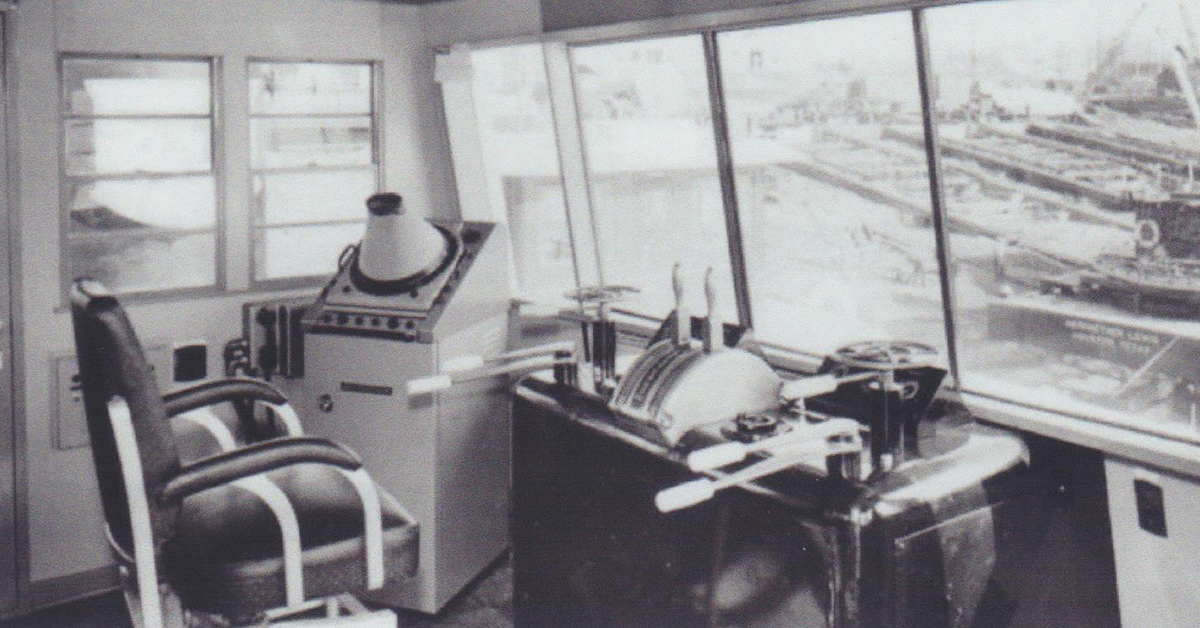The last column detailed the dedication of the Greenup Locks and Dam that featured a towboat parade. This week we will look at one of the boats that led that parade.
The Inland River Record of 1949 listed eight vessels owned by Sohio Petroleum Corporation of St. Louis. Six of these were diesel powered and ranged from the small 200 hp. Pep to the 2,415 hp. Sohioan, which, when built in 1943, was the most powerful vessel on the rivers (see The Waterways Journal, June 30, 2025).The remaining two were 2,000 hp. DPC steam towboats: the Sohio Fleetwing, originally called the Bou Arada, and the Sohio Latonia, originally named the Bataan.
The April 23, 1949, issue of The Waterways Journal carried a small story on page 9 headlined, “Newest Sohio Boat Is Christened At St. Louis.” This new boat, named Sohio Cleveland, was built by St. Louis Shipbuilding and Steel Company, measured 150 by 35 feet and was rated at 3,200 hp. The Sohio Cleveland was described as “completely streamlined and of most modern design throughout.” The crew of the new vessel included Capt. Francis M. Walters, master; Capt. W.C. Grimm, relief master; Capt. Stanley W. Roll, pilot; Charles Brindley, chief engineer; Cecil Shockley, second engineer; W.G. Dausman, junior engineer; S.F. Hughes and J.E. Thomas, oilers; Gene Baltzel, mate; J.C. Beard, relief mate; Morris Mason, watchman; and deckhands J.A. Riley, E.B. Stewart and W.O. Carroll, with John Jenkins serving as “clerk-deckhand.” Mr. and Mrs. Penny Redmon were in charge of the galley.
The May 21, 1949, issue of the WJ had a two-paragraph blurb on page 9 about the first trip of the Sohio Cleveland having been “a very fast one.” On the initial trip, the boat loaded three 290- by 50-foot barges at Mayersville, Miss., on the Lower and delivered them to Mt. Vernon, Ind., on the Ohio River. This tow averaged better than 8 miles per hour shoving against the current, and the wicket dams were thrown on the Ohio, creating “open river” conditions so that no locking was necessary.
The May 28, 1949, WJ not only had a front cover ad for St. Louis Ship featuring the Sohio Cleveland, but it also contained a feature story detailing the new vessel. An aerial photo of the boat was included, as was a shot of Mrs. Margaret Holliday, wife of W.T. Holliday, board chairman of Standard Oil of Ohio, smashing the traditional bottle of champagne on the port capstan. Other photos were of the officer’s lounge, the pilothouse and engine room.

The story noted that the Sohio Cleveland, as well as the tow of three integrated barges consisting of a bow piece, box and stern piece, had been designed and built by the St. Louis Shipbuilding and Steel Company and was “expected to be the most efficient high-speed petroleum carrying fleet on the rivers.” Hull designs for the barges were drafted after professor L.A. Baier conducted trials at the naval testing tank of the University of Michigan. The three single-skin barges had a total capacity of 81,680 barrels of gasoline at a draft of 9 feet 6 inches.
The hull of the new vessel, as previously stated, was 150 by 35 feet and had a normal operating draft of 8 feet. Fully fueled, it would carry enough for 19 days running. Propulsion for the twin-screw boat came from a pair of GM 16-278A, two-cycle marine diesels with 16 cylinders with 8 ¾ inch bore and 10 ½ inch stroke, rated 1,600 hp. at 750 rpm. The main engines were coupled to Falk 3.46:1 reverse-reduction gears with Air-flex clutches. The cast steel propellers were made by St. Louis Ship. The main engines were controlled from the pilothouse with equipment furnished by General Motors Corporation. The controls were quite large with vertical handles that traveled through indented tracks. Some have referred to that setup as “zipper” controls, and one of the last surviving examples can be found today on Amherst Madison’s mv. Charleston.
The steering rudders were St. Louis Ship’s patented “Contra-guide” design. A series of trials had been held shoving the three loaded barges, first with conventional rudders and then with the Conta-guide rudders, which yielded an 8.65 percent increase in efficiency and an increase of .45 mph with the Conta-guide rudders. These results were reported as identical to those determined in the model testing by Baier.
Air-conditioned quarters for a crew of 15 were arranged in the “streamlined deckhouse.” Furniture in the officer’s lounge was of ivory leather and was furnished by the Famous-Barr Company of St. Louis. According to the article, “Every care was taken by the builder to make this one of the most attractive and comfortable boats, as well as one of the most powerful and efficient.” The article closed with, “The Sohio Cleveland is expected to remain one of the ‘best boats on the river’ for some time to come.”
The next column will deal with the career of this noteworthy towboat.
Featured image caption: The new Sohio Cleveland as pictured in the May 28, 1949, issue of The Waterways Journal. (From the author’s collection)




